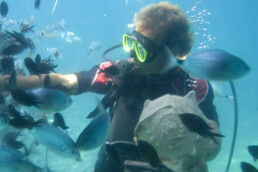You’ve been working on your site to make sure it’s as accessible to everyone as possible. You’ve been reading our posts on accessibility, and trying to make sure you’re addressing Kinesthetic, Auditory, and Visual needs. You’re hoping, in addition to making your site more open to all, that you’ll also avoid the sharks as much as possible, and to do that you’ll need an accessibility statement.
Accessibility Statement: the missing link to your visitors
What you’ve been doing is great, but one of the most important ways to make sure you’re avoiding the sharks, is to actually make sure you’re swimming with the fish. Huh? The fish: the individuals you’ve been working to accommodate! In addition to doing as much as you can to rework your site for them, it’s also important to let them know what you’re doing, and to give them a chance to let you know what they need. The way you do this is through an accessibility statement.

An accessibility statement is a little statement linked to in the footer that just explains your commitment to accessibility. It doesn’t have to be long, and in fact I’d say the shorter the better as long as you hit the major points that it needs, and you express your commitment convincingly.
How to Write It
There are basically three points you need to make in your accessibility statement. First, you need to explain how you feel about accessibility, and hopefully that’s not just that you want to avoid lawsuits.
Hopefully as you’ve begun this process of looking at your website through the eyes and ears of a diversity of users, you’ve started to realize how important true accessibility really is. Hopefully you’ve started to see that making sure everyone can access your website is the best thing for your site, and for the world. Express that well, and the first job of the accessibility statement is done.
Second, you need to explain what things you’ve been working on doing to make your site accessible. Maybe you’ve just started working on these things, and you don’t have a whole lot to show for your efforts yet. That’s okay. It’s actually best if your accessibility statement is aspirational.
It’s good to say such things as, “We’re working to make sure our menus are keyboard accessible,” or “We’re in the process of adding alt text so all our images are available for screen readers.” You don’t need to say, “We’ve made all our menus fully keyboard accessible and all our images have alt text.” That’s not what’s needed. You don’t need to be perfect. If you claim to be, someone will go to great lengths to figure out how you’re not. No, what you need to do is explain that you’re working on it. Demonstrate intent, and really do work on it!

This is a Contact Sport
Last, and probably the most important part, is to provide contact information for someone at your company that can get the people the information they need if it’s still inaccessible. You also need to convey the assurance that as a company you will work to make accessible whatever aspect of your site was problematic to the individuals.

It’s best to provide at least a couple options here—let them choose their path to you. Phone number and email address would work, but if you’re worried about exposing your email address directly to the web and all the bots that troll it, a keyboard-accessible form with safeguards against bots would work too. You’d get bonus points if you include a link to an accessible chat option.
The key is a quick response time. Do something to make sure any concerns that come to you through this channel are addressed quickly, within a couple of hours, if possible, if not a matter of minutes. The speed of your response will demonstrate how seriously you take this issue better than just about anything else you could do.
No Shortcuts
I’ve said this statement can be short, and you’ve seen how basic the requirements of it are, but don’t just dash it off. Treat it like the other content in your website by using our Quick and Dirty method which, if you’ve used it on your content, you know is indeed quick, but not easy. Do the work that it takes, though, and you’ll show your visitors your concern. Then, all those fish darting around your site will turn to you when they have problems, rather than to the sharks.
Contact us for a consultation and we'll work with you to make sure the fish know you're on their side, and that they're at your side rather than a shark.
Read more in our Accessibility series
Bulls Can’t See Red, Can Sharks?
Web Design,Accessibility,Web Development
November 14, 2022
If the contrast ratios throughout your site are high enough, it’ll make it easy for all your visitors to have a great experience and want to come…
0 Comments15 Minutes
Sharks in the Water 3: Now See Here!
Web Design,Accessibility,Web Development
September 15, 2021
You’re looking a shark (lawyer) in the eye, trying to stare it down, but you’re struck by the irony that seeing is the whole problem in the first…
0 Comments9 Minutes
Keeping the Sharks at Bay Part 2: Don’t move!
Web Design,Accessibility,Web Development
August 19, 2021
The sharks are circling you, but the letter they sent you didn’t mention anything about auditory challenges, so our last installment of the series…
0 Comments8 Minutes
Keeping Sharks at Bay Part 1: Your Site’s for Everyone, You Hear?
Web Design,Accessibility,Web Development
May 28, 2021
By the end of this three-step process, you’ll have addressed the various issues you face. It’s impossible to instantaneously fix everything about…
0 Comments6 Minutes







